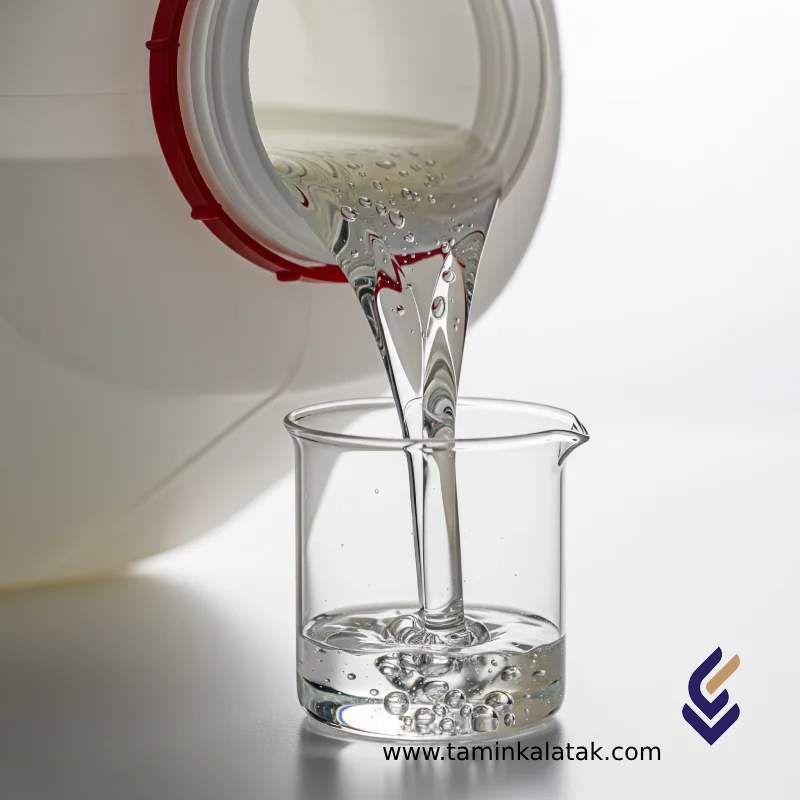liquid Caustic
Caustic Soda Liquid, also known as Sodium Hydroxide Solution, is a highly alkaline, colorless, transparent, and strongly corrosive liquid typically produced and supplied in 30% to 50% concentrations by weight.
It is one of the most essential basic chemicals in global industry, widely used in processes such as neutralization, purification, etching, cleaning, and pH control.
Chemical Structure of Caustic Soda Liquid
-
Chemical Name: Sodium Hydroxide Solution
-
Chemical Formula: NaOH(aq)
-
CAS Number: 1310-73-2
-
Structure: Ionic solution containing Na⁺ and OH⁻ ions in water
-
Molecular Weight (NaOH): 40.00 g/mol
-
Common Industrial Concentration: 50% w/w (partially saturated solution at ambient temperature)
Physical and Chemical Properties (50% Solution)
| Property | Specification |
|---|---|
| Appearance: | Clear, colorless, odorless liquid |
| Density (20°C): | 1.515 – 1.520 g/cm³ |
| Freezing Point: | Approx. +12°C (hydrate crystallization begins at this concentration) |
| Boiling Point: | ~143°C |
| pH (1% solution): | Around 14 |
| Viscosity (20°C): | 3.4 – 3.6 mPa·s (higher than water) |
| Solubility in Water: | Complete – highly exothermic reaction |
| Appearance: | Transparent and free-flowing with no suspended particles |
Applications
1. Basic Chemical Industry
-
Neutralization of acids and pH regulation
-
Reactant in the production of detergents, bleaches, resins, paints, and adhesives
2. Water and Wastewater Treatment
-
pH adjustment and removal of heavy metal ions
-
Neutralization of acidic effluents
3. Pulp and Paper Industry
-
Used in the Kraft process for lignin separation from cellulose
-
Bleaching and paper recycling
4. Oil, Gas, and Petrochemical Industry
-
Gas sweetening (removal of H₂S and CO₂)
-
Purification of industrial oils and acid neutralization
5. Food Industry (Food Grade – FCC)
-
Cleaning-in-Place (CIP) systems for food processing lines
-
Olive curing (Lye Processing) and cocoa refining under controlled concentrations
Advantages
✅ Ready-to-use liquid form – suitable for direct dosing or injection
✅ High stability in solution – no need for prior dissolution
✅ Easier handling and transport compared to solid NaOH
✅ Versatile – applicable across chemical, food, and industrial sectors
Disadvantages
⚠️ Highly corrosive to skin, eyes, light metals, and non-resistant materials
⚠️ Exothermic reaction during dilution → always add caustic soda to water, never the reverse
⚠️ Requires corrosion-resistant storage tanks (HDPE or lined carbon steel)
⚠️ Absorbs CO₂ from air → gradual decrease in purity during long-term storage
Safety and Handling
GHS Classification:
-
H314: Causes severe skin burns and eye damage
-
P280: Use appropriate personal protective equipment
Required PPE:
-
Alkali-resistant gloves (Neoprene or PVC)
-
Safety goggles and face shield
-
Respiratory protection in areas with vapor or spray exposure
Emergency Measures:
-
Skin/Eye Contact: Immediately flush with plenty of cold water for at least 15 minutes and seek medical attention
-
Ingestion: Do not induce vomiting; drink plenty of water and seek emergency medical care
Storage Conditions
-
Store in HDPE tanks or epoxy-lined carbon steel containers
-
Optimal temperature: 15°C – 35°C
-
Keep away from acids, light metals, and chlorinated organic compounds
-
Avoid contact with moisture and CO₂
Standard Industrial Packaging
-
220-liter drums
-
1000-liter IBC tanks
-
Bulk transport in alkali-resistant tankers
Summary
Caustic Soda Liquid (NaOH 50%) is a versatile, high-strength alkaline solution essential for a wide range of industrial, petrochemical, and environmental applications.
Its ready-to-use form, strong reactivity, and broad compatibility make it one of the most widely used and economically valuable chemical bases in modern industry.
Applications
| Applications | , , , , , |
|---|
liquid Caustic
| Products | Chemical formula | Density (at 20°C) | Melting point | CAS number | Grade | Solubility in water | Vapor pressure | Physical appearance |
|---|---|---|---|---|---|---|---|---|
| Sodium hydroxide solution | NaOH(aq( | 1.515 – 1.520 g/cm³ (for 50% solution) | About +12°C (for 50% solution – hydrate formation) | 1310-73-2 | Industrial, edible (FCC – in controlled concentrations), laboratory | Complete – highly exothermic reaction | Very low (less than 0.1 mmHg at 20°C) | Clear, colorless, odorless liquid |







